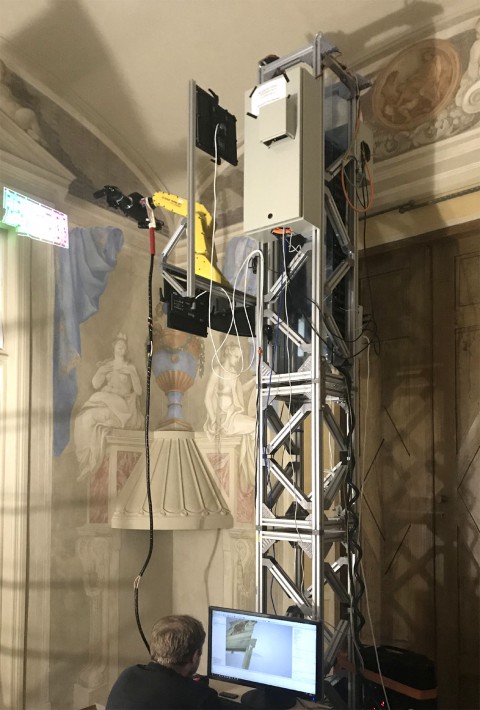Show What Is Hidden
One of the elements of the task “Development of three-dimensional documentation of the collection”, carried out by the Warsaw University of Technology, is to prepare spatial measurement documentation of the al Fresco Cabinet interior. The room, measuring 4.15 m by 4.15 m and 4.95 m high, is located on the ground floor of the palace in the northern section of the main body, and all its walls are decorated with frescos by Jerzy Eleuter Siemiginowski.
The small size of the Al Fresco Cabinet means that, for conservation reasons, access to it is very limited and visitors to the museum can only admire it through the open door from the adjacent Queen’s Antechamber. For this reason, we decided to make a three-dimensional documentation of the surface of the four walls and the ceiling in an unprecedented architectural resolution of 100 measurement points per mm2 of surface. This high scanning accuracy (reproducing all the features of a model’s geometry at 0.2 mm) creates a documentation that provides the possibility of a very versatile use. On the one hand, it is an extremely reliable representation of the state of preservation of the room at the beginning of the 21st century and can be a point of reference for all conservation activities in the future. On the other hand, it gives the possibility of digital visualisation of both the entire room and its fragments (apart from data on geometry, information about colour is also recorded for each measuring point).
The measurements are carried out using the structural lighting scanning technique, with an innovative measurement system, the prototype of which was built several years ago at the Faculty of Mechatronics of the Warsaw University of Technology. The device consists of a measuring system (scanning head) mounted on the arm of an industrial robot, which in turn moves vertically along a special column. The whole system is mounted on a mobile platform enabling the system to be rolled along the walls of the room. Due to such a high measurement accuracy, the full volume of the collected data will be over 5 TB (measurements are still ongoing) and will be a component of over eight thousand directional measurements. Processing such large amounts of data is a huge technological challenge, which is why the process is even more complicated and laborious than the scanning itself. In terms of completeness and quality of the documentation, this is an unprecedented activity in the global practice of digitisation of architectural interiors.
It should be mentioned that the Al Fresco Cabinet is the fourth interior of the Wilanów Palace to be documented in this way. Creating a methodology and technical background for such innovative activities was possible only thanks to eleven years of research cooperation between the Museum and the Warsaw University of Technology in developing specialised systems for three-dimensional documentation of cultural heritage objects. With such technologically advanced documentation, we have a real chance to present the viewers with details of the interior of the room, to which physical access will always be very limited. We are also conducting experiments in the field of VR (virtual reality) and AR (augmented reality). An example of such actions was the article published a few weeks ago as part of the 17th Culture and Computer Science conference in Berlin, showing attempts to visualise spatial data from one of the previously scanned rooms in the Wilanów Palace – the King’s Chinese Cabinet (see P. Siekański, E. Bunsch, A. Guzowska, R. Sitnik, “Managing Large Sets of Multidisciplinary Research Data Using 3D Models of Cultural Heritage Objects and Augmented Reality: Case Study of King's Chinese Cabinet in Wilanów”, in: 17th Culture and Computer Science. Virtual history & augmented present, Berlin 2019, p.191-200). The use of sophisticated technical means is therefore not only to create virtual, digital entities parallel to the reality of the museum, but also to make it possible to record and make available what cannot be shown to visitors even during their stay in the museum.
LIST OF ILLUSTRATIONS:
Fig. 1 System for three-dimensional scanning with structural lighting during work in Al Fresco Cabinet (photo E. Bunsch)
Fig. 2 Documentation of the Al Fresco Cabinet, view of the eastern wall of the room. Visualisation of a simplified layer of data from 3D measurement.
Fig. 3 Documentation of the Al Fresco Cabinet, detail on the northern wall of the room. Visualisation of a dense measurement point cloud.
text and photos: Eryk Bunsch

suggested

How to show the inaccessible – three-dimensional scanning of the Queen’s Antecabinet
The interiors of the Wilanów Palace are characterised by an unprecedented richness and diversity of the elements present in them. …

Accurate scanning for documentation purposes
In the fourth quarter of 2017, at the Museum of the Palace of King Jan III in Wilanów, the implementation …

Acts of vandalism threatening research projects?
Vandalism is, by definition, “the deliberate destruction of someone else’s property, especially public property, without a clear reason”. Unfortunately, this …

















